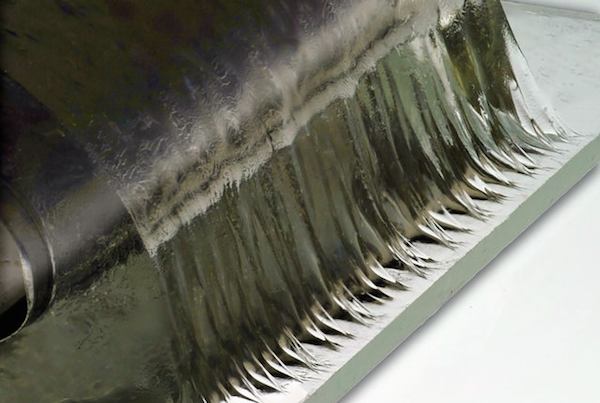
[Image above] Engineered hydrogel being pulled away from a glass surface. The material shows a property called “tough wet adhesion” comparable to tendon and bone interface. The wavy edge instability at the interface is a hallmark of strongly adhered soft material on a rigid surface. Credit: Felice Frankel
The mission to develop smarter materials pushes forward, and scientists, researchers, and engineers are turning to Mother Nature for inspiration.
Last month, we covered the latest research from the University of Akron (Akron, Ohio) and Virginia Polytechnic Institute (Blacksburg, Va.) that’s exploring the “properties underlying spider glue’s humidity-responsive adhesion, which might lead to much-sought-after ‘smart adhesives’ that have the ability to function even in high-humidity conditions,” according to a recent American Institute of Physics news release.
But spider silk isn’t the only natural model for creating smarter synthetic adhesives.
Engineers at the Massachusetts Institute of Technology have “developed a method to make synthetic, sticky hydrogel that is more than 90 percent water” that is “tougher than natural adhesives employed by mussels and barnacles,” according to a recent MIT News article.
The material is transparent and rubber-like and can adhere to surfaces like glass, silicon, ceramics, aluminum, and titanium “with a toughness comparable to the bond between tendon and cartilage on bone,” the article explains.
For example, in a related MIT News video the hydrogel material is glued to a silicon wafer, which is then smashed with a hammer. “While the silicon shatters, its pieces remain stuck in place due to the tough bonding,” the video explains.

Credit: MIT; YouTube
But this hydrogel isn’t just tough—it’s super flexible, too.
The video demonstrates this flexibility by connecting four ceramic bars with the hydrogel. “The resulting structure can be deformed into various modes due to the flexible and tough hydrogel joints,” the video explains.
“It’s a pretty tough and adhesive gel that’s mostly water,” Hyunwoo Yuk, a graduate student in mechanical engineering and lead author of a paper on the work, says in the article. “Basically, it’s tough, bonding water.”
And this material is highly conductive.
To test this, the team added salts to a hydrogel sample and attached the hydrogel to two metal plates connected by electrodes to a small LED light. As a result, “the hydrogel enabled the flow of salt ions within the electrical loop, which lit up the LED,” the article explains.
The video illustrates how an “ionic hydrogel chemically anchored on two metal electrodes is conductive enough to power a LED light even when the hydrogel is stretched up to 4.5 times its original size.”
The hydrogel’s conductive properties give it the potential to be used in soft robotics and bioelectronics, which the team is researching.
The paper, published in Nature Materials, is “Tough bonding of hydrogels to diverse non-porous surfaces” (DOI:10.1038/nmat4463).
Author
Stephanie Liverani
CTT Categories
- Material Innovations
- Weekly Column: “Other materials”
Related Posts
Other materials stories that may be of interest for December 17, 2025
December 17, 2025
Other materials stories that may be of interest for December 10, 2025
December 10, 2025
Other materials stories that may be of interest for December 3, 2025
December 3, 2025
